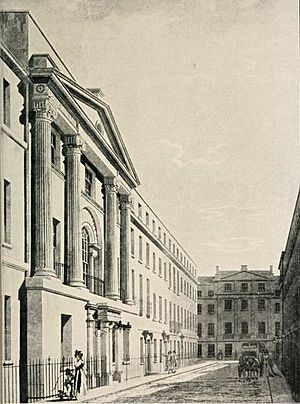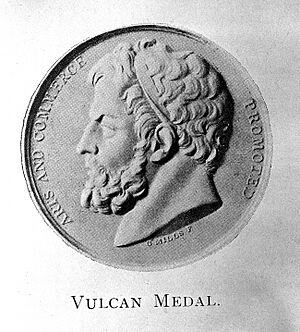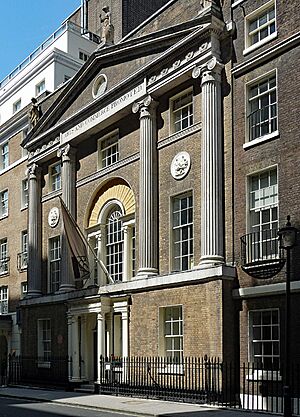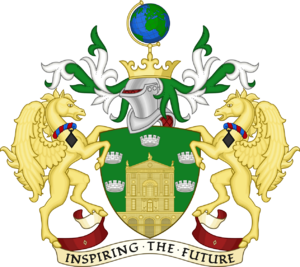Royal Society of Arts facts for kids
 |
|
| Abbreviation | RSA |
|---|---|
| Established | 1754 |
| Founder | William Shipley |
| Founded at | London, England |
| Type | Registered charity |
| Legal status | Royal Charter Company |
|
Professional title
|
FRSA |
| Headquarters | 8 John Adam Street London, WC2N 6EZ |
| Fields | Arts and culture |
|
Membership
|
30,000+ fellows |
|
Official language
|
English |
|
Chairman
|
Sir Loyd Grossman |
|
CEO
|
Andy Haldane |
|
Formerly called
|
Society for the Encouragement of Arts, Manufactures and Commerce |
The Royal Society of Arts (RSA) is a special group that encourages new ideas and progress in many areas. It helps people be creative, supports social improvements, and works for a healthy planet. The RSA connects people who want to make a difference. It aims to help "people, places, and the planet to thrive in harmony."
The RSA started in a coffee house in London in 1754. It began as a UK group but is now an international society. It works to improve "everything and anything." The RSA has changed and grown over time to keep up with new challenges. It is always focused on making society better.
Many famous people have been part of the RSA. These include Charles Dickens, Benjamin Franklin, Stephen Hawking, Marie Curie, Nelson Mandela, David Attenborough, and Tim Berners-Lee. Today, the RSA has members from 80 countries around the world.
Contents
History of the RSA
The RSA was started in 1754 by William Shipley. It was first called the Society for the Encouragement of Arts, Manufactures and Commerce. In 1847, it received a special permission called a Royal Charter. This allowed it to use the name "Royal Society of Arts" from 1908, given by King Edward VII. From 1914, its members became known as 'Fellows'.
In the 1800s, the RSA helped organize The Great Exhibition. This huge event showed off new industrial technology and designs. Important people like Prince Albert and Henry Cole were involved.
RSA Leaders and Patrons
The RSA has a special patron, Anne, Princess Royal. She became President in 2011, taking over from her father, Prince Philip, Duke of Edinburgh. The current chairman is Tim Eyles. The chief executive since September 2021 is Andy Haldane, who used to be a top economist at the Bank of England.
Past Presidents of the RSA
- 1755–61: Jacob Bouverie, 1st Viscount Folkestone
- 1761–93: Robert Marsham, 2nd Baron Romney
- 1794–1815: Charles Howard, 11th Duke of Norfolk
- 1816–43: Prince Augustus Frederick, Duke of Sussex
- 1843–61: Albert, Prince Consort
- 1862: William Tooke
- 1863–1901: Albert Edward, Prince of Wales
- 1901: Sir Frederick Bramwell
- 1901–10: George, Prince of Wales
- 1910–10: Richard Webster, 1st Viscount Alverstone
- 1911–42: Prince Arthur, Duke of Connaught and Strathearn
- 1942–43: Sir Edward Crowe
- 1943–45: E. F. Armstrong
- 1945–47: Richard, Viscount Bennett
- 1947–52: Elizabeth, Duchess of Edinburgh
- 1952–2011: Prince Philip, Duke of Edinburgh
- 2011–present: Anne, Princess Royal
Becoming an RSA Fellow
People can become Fellows if they agree with the RSA's goals and values. Some people are invited to join because of their important work. Others are suggested by current Fellows or RSA staff. You can also apply yourself with references. An admissions panel reviews all applications.
Fellows of the RSA can use the letters FRSA after their name. They can also use the RSA Library and other buildings in London. Fellows pay a yearly fee to support the RSA's charity work. There is also a one-time fee for new Fellows.
RSA Awards and Medals
When it started, the RSA gave out "prizes" for 100 years. These prizes included medals and sometimes money. They were given to people who succeeded in challenges. These challenges were in areas like farming, arts, manufacturing, and chemistry. For example, people won for new ways to grow crops or for inventing machines.
One famous winner was Edwin Landseer. At just 10 years old, he won a silver medal for his drawing of a dog. In 1823, Augustus Siebe won the Vulcan medal for an improved tool.
Today, the RSA still gives out important awards. These include the Albert Medal, the Benjamin Franklin Medal, and the Bicentenary Medal. Famous winners include Nelson Mandela, Sir Frank Whittle, and Professor Stephen Hawking.
Royal Designers for Industry
In 1936, the RSA started giving out a special award called Royal Designers for Industry (RDI or HonRDI). This award is for "those very few who have shown amazing skill in design for industry."
The "Faculty of Royal Designers for Industry" was created in 1937. It helps promote excellent design. Only RDIs and HonRDIs can be members. There are only 120 Royal Designers (RDI) and 45 Honorary Royal Designers (HonRDI) at any one time.
These designers work in many different fields. They include engineering, graphics, product design, fashion, and urban design. Famous past and present members include Sir Jonathan Ive, Dame Vivienne Westwood, Sir James Dyson, and Sir Tim Berners-Lee.
RSA Activities and Events
The RSA has regional groups in Great Britain and Ireland. These groups help Fellows connect and work on local issues. The RSA also has a presence around the world, including in Australia, New Zealand, and the United States.
Public Events
The RSA holds many public events. These include lectures, discussions, and film screenings. They share important ideas and debates with everyone. Over 100 events are held each year. Many are streamed live online. You can also find audio and video recordings on the RSA's website and YouTube page.
Many well-known speakers have shared their ideas at the RSA. These include Ken Robinson, Al Gore, Sir David Attenborough, and Yuval Noah Harari.
RSA Animate Videos
The RSA creates short, animated videos called "RSA Animate." These 10-minute whiteboard animations are based on talks given at RSA events. They make important ideas easy to understand and share. The videos are produced by the RSA, and the animations are made by RSA Fellow Andrew Park.
By 2011, the first 14 RSA Animate videos had over 46 million views. This made the RSA's YouTube channel the most popular non-profit channel worldwide.
RSA Projects
The RSA has started many important projects over the years.
- In 1882, it offered the first national public exams. This led to the creation of the Oxford, Cambridge and RSA Examinations Board.
- In 1876, the RSA helped found the National Training School for Music. This school later became the Royal College of Music.
- The RSA came up with the idea of placing plaques on buildings to mark where famous people lived. These are now known as "blue plaques." The first plaque was red and honored Lord Byron. The scheme is now run by English Heritage and other groups.
- In 1929, the RSA bought the entire village of West Wycombe. After fixing it up, they gave it to the National Trust.
- In 2008, the RSA became a sponsor of an academy school in Tipton, called The RSA Academy. It opened in September 2008. The RSA has six schools in the West Midlands.
Past projects include helping provide clean drinking water and exploring ways to manage international migration. The RSA also works with artists to share ideas about protecting the environment.
RSA House in London
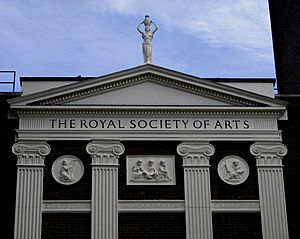
The RSA moved to its current home in 1774. The building is on John Adam Street in central London. It was designed by the Adam Brothers as part of their Adelphi project. The main building has the Great Room, which has beautiful paintings by James Barry. These paintings show "The Progress of Human Knowledge and Culture."
The RSA has grown and now includes other nearby buildings. One of these buildings, 18 Adam Street, used to be a tavern mentioned in Dickens's The Pickwick Papers. This building has a beautiful ceiling with painted designs.
In 2012, the RSA building was updated. This work won awards for its design and for keeping the historic building special.
Groups Connected to the RSA
The RSA played a role in creating London's Royal Academy of Arts. In 1755, RSA members tried to start an art academy. Although their first attempt didn't work, the plan they drew up was used to create the Royal Academy of Arts later. The RSA also held the first exhibition of contemporary art in 1760. Famous artists like Thomas Gainsborough and Joshua Reynolds showed their work there. They later helped found the Royal Academy of Arts.
An exhibition of photography in 1852 led to the creation of the Photographic Society of London in 1853.
RSA Coat of Arms
More to Explore
- First Exhibition (1760)
- List of fellows of the Royal Society of Arts
- Society for the Encouragement of Arts, Manufactures and Commerce
See also
 In Spanish: Royal Society of Arts para niños
In Spanish: Royal Society of Arts para niños


